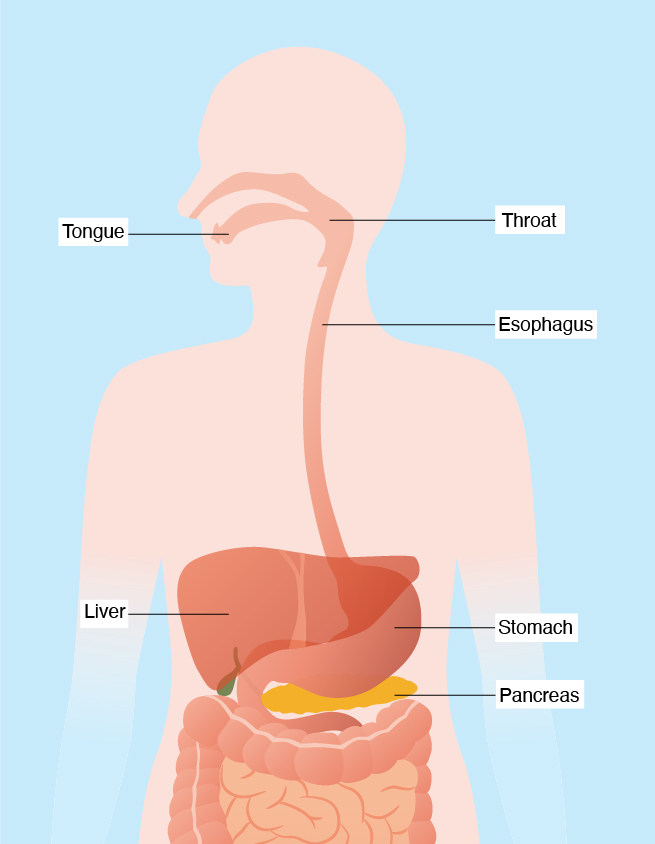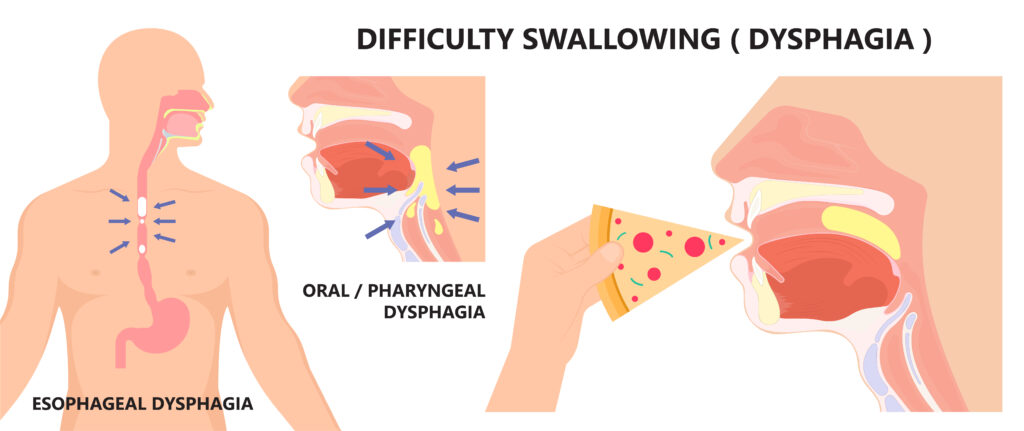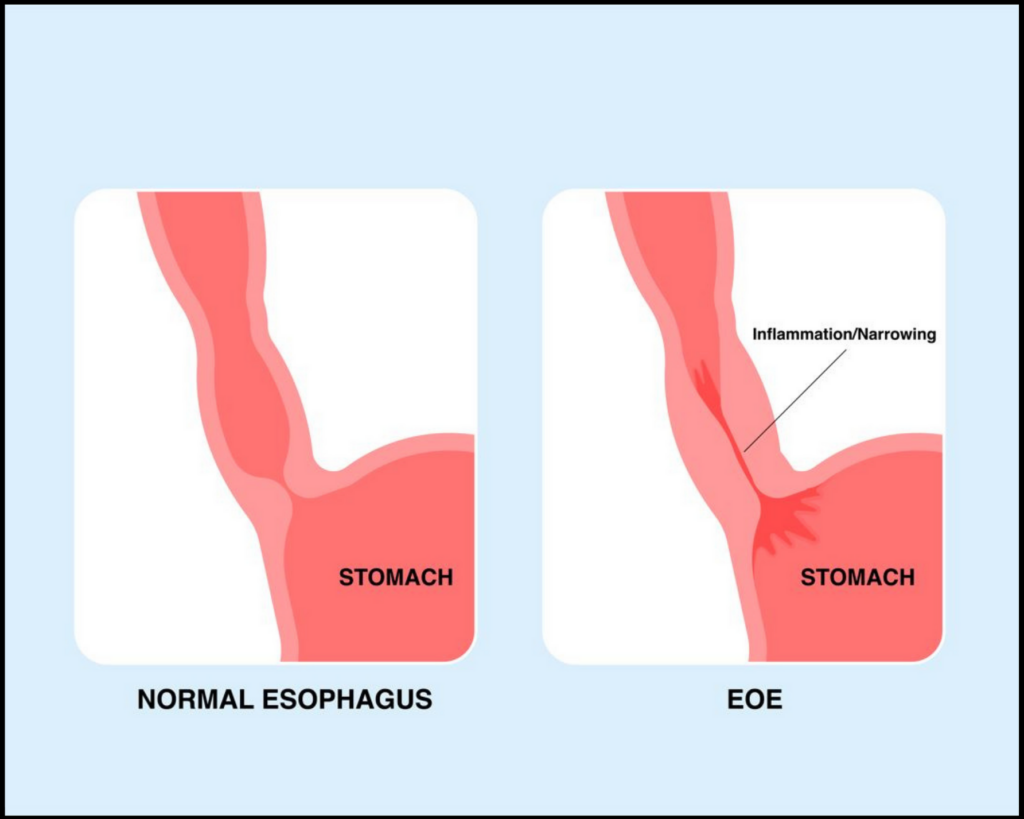What is Eosinophilic Esophagitis (EoE)?

Eosinophilic Esophagitis (“ee-o-sin-o-fil-ik” “uh-sof-uh-jie-tis”) or EoE, is a condition that affects the esophagus, the tube that carries food from the mouth to the stomach.
EoE is triggered by a variety of genetic, immune, and external factors. EoE may develop as a delayed allergic response to certain foods, most commonly cow’s milk, wheat, soy, egg, and less commonly peanut and fish. It may also be triggered by environmental factors, for example swallowing or breathing in allergens like pollen. EoE is considered a non-IgE mediated food allergy and symptoms are generally not life-threatening, in contrast to IgE mediated food allergy, which can potentially trigger a life-threatening allergic reaction (anaphylaxis). With EoE, large numbers of eosinophils (a type of white blood cell) collect in the esophagus due to inflammation, leading to symptoms.
Who is affected by EoE?
EoE affects both children and adults and can develop at any age, including infancy. The majority of people are diagnosed in childhood (school-age kids) or adulthood (adults in their thirties). It affects mostly males (ratio of 3 to 1) and approximately 1 person per 1,000 people are diagnosed with EoE. People with EoE often have other allergic conditions such as asthma, eczema, seasonal allergies and IgE mediated food allergy, but not always.
What are the symptoms of EoE?
EoE symptoms can vary by person and age. Most commonly, people complain of difficulty swallowing (called dysphagia). Types of dysphagia include a feeling of food going down more slowly or sticking in the chest. It can occur occasionally or happen every time a person eats. The symptoms range from mild discomfort with little or no pain to very painful and distressing.
Please refer to the chart below to see the most common symptoms associated with EoE.
Symptoms in children
In children, the symptoms are less consistent, and a wide variety of symptoms can be experienced, like difficulty swallowing and regurgitating/vomiting. Toddlers may experience difficulty transitioning to solid foods.

Symptoms in adults
In adults, the most common symptom is difficulty swallowing food (dysphagia). With this symptom, food may feel like it is travelling slowly down the esophagus, and the person may experience a sensation of food sticking in their throat or in their chest.

Other symptoms can include food impaction (when food becomes stuck in the esophagus), heartburn and chest pain.
Dealing with symptoms
People with EoE often alter their eating patterns or make lifestyle changes. For instance, they may take much longer to eat, chew excessively and be the last to finish a meal. They may avoid certain foods like meat and bread and prefer softer, moister foods. They may also drink lots of fluids during a meal.
Many patients do not realize they have an underlying condition and simply consider themselves to be slow eaters. However, increased awareness about the condition and its symptoms are leading more to seek help and treatment.
- If you think you might have EoE, but you’re not sure, visit allergycheck.ca and talk to your doctor.
| EoE Signs and Symptoms (in order of most frequently to least frequently reported) | Children < 5 years of age | Children ≥ 5 years of age | Adolescents | Adults |
|---|---|---|---|---|
| Difficulty swallowing (dysphagia) | ✓ | ✓ | ✓ | ✓ |
| Food sticking | ✓ | ✓ | ✓ | ✓ |
| Chest pain | ✓ | ✓ | ✓ | ✓ |
| Abdominal pain | ✓ | ✓ | ✓ | ✓ |
| Prolonged meal times | ✓ | ✓ | ✓ | ✓ |
| Excessive amounts of fluid intake with meals | ✓ | ✓ | ✓ | ✓ |
| Avoidance of certain food textures (such as dry meats, bread, rice, harder foods) | ✓ | ✓ | ✓ | ✓ |
| Heartburn | ✓ | ✓ | ✓ | |
| Food impaction (when food becomes stuck in the esophagus) – this is a medical emergency | RARE | INFREQUENT | ✓ | ✓ |
| Poor weight gain/growth | ✓ | ✓ | ✓ | |
| Vomiting | ✓ | ✓ | ✓ | ✓ |
| Regurgitation | ✓ | |||
| Food refusal (fussy eaters) | ✓ |
What causes EoE?
EoE is triggered by a variety of genetic, immune, and external factors. In some cases, it can be a delayed allergic response to certain foods. This delayed response is very different from the immediate allergic response (anaphylaxis) that these patients can also be susceptible to having. Environmental factors, such as pollen can also contribute to inducing EoE.
Common food triggers

The foods most commonly associated with EoE are the following:
- Cow’s milk
- Wheat
- Soy
- Egg
Less commonly associated foods are the following:
- Peanut / tree nuts (e.g., almonds, cashews, chestnuts)
- Fish / shellfish [crustaceans (e.g., lobster, shrimp) and molluscs (e.g., scallops, clams)]
What happens if EoE is not diagnosed or treated?
It is important to note that EoE is a lifelong, chronic condition that needs to be managed. It will not go away on its own. The sooner a person is diagnosed and treated, the better they can manage their symptoms and help to control the inflammation in their esophagus. Symptoms can vary from one person to another, and they usually involve difficulty getting food down the esophagus when swallowing (eating).
People may not realize they have EoE and will just adapt their eating behaviours. They may do so by avoiding certain foods or developing different ways to deal with food getting stuck in their throat or in their chest. For example, people with EoE chew their food more than other people, they tend to drink between each mouthful, they are often last to finish their meals, and in some cases, they will mince or puree their foods with a blender to make them easier to eat. If they don’t know they are dealing with a health condition, they may not seek medical help until their condition worsens.
At times, the condition also causes some people to avoid eating out in restaurants or socialize, and as a result, they isolate themselves, which can further affect their quality of life.

Over time, if EoE is not diagnosed or is left untreated, the inflammation in the esophagus can, in some cases, cause narrowing from scar tissue to the point where it becomes more and more difficult to swallow food. The long-term consequences of EoE can lead to a narrowing of the esophagus, called a stricture. These strictures, caused by constant inflammation over long periods of time, make the esophagus rigid, causing food to become lodged or stuck (impaction). When this occurs, people are more likely to need emergency medical care. Strictures represent a more severe form of the disease.




